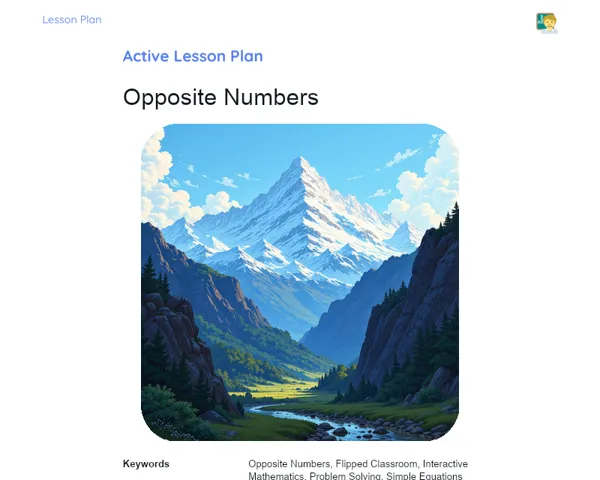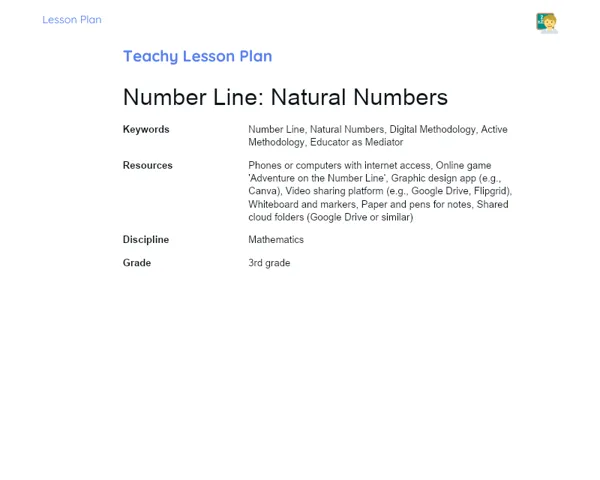Lesson Plan | Lesson Plan Iteratif Teachy | Internal Angles of Quadrilaterals
| Keywords | Internal Angles, Quadrilaterals, Mathematics, Digital Methodology, Interactive Activities, Active Learning, Technology, Social Media, Critical Thinking, Teamwork |
| Resources | Cell Phones, Tablets, Internet Access, Notebooks or digital devices for notes, Video recording and editing apps (iMovie, InShot, Adobe Spark), Video sharing platform (Google Classroom or class's social media group), Online game 'Angle Detectives' |
| Codes | - |
| Grade | 8th grade |
| Discipline | Mathematics |
Goal
Duration: 10 - 15 minutes
The purpose of this stage is to ensure that students clearly understand the main objectives of the lesson, laying a solid foundation for the practical activities that follow. This way, students will be ready to efficiently apply previously studied concepts in a practical way during the lesson.
Goal Utama:
1. Understand that the sum of the internal angles of a quadrilateral is always 360°.
2. Apply knowledge to calculate the missing angle when three internal angles of a quadrilateral are known.
Goal Sekunder:
- Encourage critical thinking and problem-solving.
- Promote collaboration among students by discussing problems and solutions.
Introduction
Duration: 10 - 15 minutes
The purpose of this stage is to ensure that students grasp the main objectives of the lesson, providing a strong basis for the practical activities that come next.
Warming Up
📱 Introduction: Kick off the lesson by reminding students that the sum of the internal angles of a quadrilateral is always 360°, which is a key concept in geometry. Challenge the students to use their cell phones to find an interesting fact about quadrilaterals or their internal angles. This will not only make the lesson more interactive but will also connect previous learning with new and intriguing information.
Initial Thoughts
1. ✨ What is the sum of the internal angles of a quadrilateral?
2. 📊 How can you use the sum of angles to find a missing angle?
3. 🔍 Are there different types of quadrilaterals? What are they and how do their angles differ?
4. 🤔 Why is it crucial to understand the sum of the internal angles in quadrilaterals in real life?
5. 🔎 Did anyone come across any surprising facts about quadrilaterals during their research?
Development
Duration: 70 - 80 minutes
This stage aims to immerse students in practical situations where they can apply the theory learned about the sum of the internal angles of quadrilaterals. By incorporating modern technologies and current dynamics, we aim to engage students more deeply, making learning enjoyable. Additionally, the activities focus on developing skills in collaboration, communication, and critical thinking.
Activity Suggestions
Activity Recommendations
Activity 1 - Angle Detectives 🕵️♂️
> Duration: 60 - 70 minutes
- Goal: Apply the concept of the sum of the internal angles of a quadrilateral to calculate unknown angles in contextual situations, encouraging active learning and teamwork.
- Deskripsi Activity: In this activity, students become math detectives! They will solve a mystery involving missing angles in various quadrilaterals found in a virtual setting. Using tablets or cell phones, students will engage in an online game where they encounter everyday scenes (like building design, interior decorating, or garden plans) featuring quadrilaterals with three known angles and one missing angle. They must calculate this missing angle to unravel the mystery and move to the next level.
- Instructions:
-
Divide students into groups of up to 5.
-
Access the online game 'Angle Detectives' using the provided link.
-
Each group should select a scene to start calculating the missing angles.
-
Students must write down their calculations in a notebook or on a digital device.
-
Once a scene is solved, students can progress to the next one, earning points and clues for the final mystery.
Activity 2 - Geometric Influencers 📸
> Duration: 60 - 70 minutes
- Goal: Empower students to explain and creatively apply mathematical concepts using digital tools and boost their communication skills.
- Deskripsi Activity: Students will step into the shoes of digital influencers who need to create explanatory content for their social media about the sum of the internal angles of quadrilaterals. Using their cell phones to record and edit, each group must produce a short video (3 to 5 minutes) that explains the concept with practical examples. They can incorporate animations, drawings, or editing apps to make their video more engaging.
- Instructions:
-
Group up to 5 students.
-
Create a video script that includes an introduction to the concept, practical examples, and a conclusion.
-
Use cell phones to record and edit the video. Apps like iMovie, InShot, or Adobe Spark will come in handy.
-
At the end, each group should share their video on a designated platform (like Google Classroom or the class's social media group).
-
Classmates and the teacher will watch and provide feedback on the videos.
Activity 3 - Quadrilateral Challenge on TikTok 🎨
> Duration: 60 - 70 minutes
- Goal: Encourage the use of social media platforms for educational purposes, making maths learning engaging and relevant to students' lives.
- Deskripsi Activity: In this fun activity, students will take part in a TikTok challenge, where they must solve problems around the internal angles of quadrilaterals in brief and creative videos. Each group will create a video that addresses a specific problem and then challenge another group to tackle a different problem. Videos should be entertaining, making use of TikTok trends and features.
- Instructions:
-
Organise the class into groups of up to 5 students.
-
Each group will receive a problem about quadrilaterals and must create a TikTok video explaining and solving it.
-
Add music, effects, and transitions to make the video appealing.
-
Once the video is published, each group must tag another group to challenge them.
-
The TikToks will be shared and discussed in class and on the class's social media platform, if applicable.
Feedback
Duration: 15 - 20 minutes
This stage encourages reflection and consolidation of knowledge gained during the lesson, promoting self-assessment and collective learning. The group discussion allows sharing experiences, while 360° feedback enhances social and communication skills vital for collaborative learning.
Group Discussion
📢 Group Discussion: Facilitate a discussion with all students. Ask each group to share what they learned from their activities and their key takeaways. Use the following prompts to guide the discussion: 1. Get each group to summarise their activities, highlighting any challenges faced and how they were resolved. 2. Encourage reflection on how digital tools and social media aided their understanding of maths concepts. 3. Prompt discussion on different approaches to solve similar problems in everyday contexts.
Reflections
1. 🔍 What were the main difficulties encountered during the activities and how did you overcome them? 2. 📚 How did using technology and social media shape your learning about the sum of the internal angles of quadrilaterals? 3. 💡 How can you apply what you've learned about quadrilaterals in real-life scenarios?
Feedback 360º
📬 360° Feedback: Conduct a 360° feedback session where each student receives feedback from their peers. Explain the importance of constructive and respectful insights. Guide them to follow these steps: 1. Point out the positives, like teamwork, creativity, or calculation accuracy. 2. Offer gentle suggestions for improvement, providing practical ideas to enhance their skills. 3. Use the formula: 'I liked... because...; You could improve by... doing...' to structure the feedback.
Conclusion
Duration: 10 - 15 minutes
📝✨ Final Purpose: This stage aims to solidify the knowledge acquired during the lesson, illustrating how what was learned applies to real life and current contexts. By summarising the content engagingly, tying it to everyday experiences, and discussing practical applications, we aim to meaningfully wrap up the lesson, fostering a culture of continuous learning and highlighting maths as a valuable tool in many life scenarios.
Summary
🎉💨 Fun Summary: Well done, angle detectives and geometric influencers! Today we cracked the code on internal angles of quadrilaterals, learning that their sum is always 360° (just like a full spin on a roulette!). We applied our maths skills to find missing angles and created fantastic content for social media. Maths turned into a proper digital adventure!
World
🌍🔗 Link to Today’s World: In our tech-driven world, mastering mathematical concepts and articulating them clearly and creatively is essential. The ability to solve problems and communicate complex ideas is crucial in diverse fields ranging from design to programming and digital content creation. This lesson seamlessly aligned maths with modern dynamics, illustrating that geometry is relevant across many aspects of our digital lives.
Applications
📊📱 Applications in Everyday Life: Understanding the sum of internal angles in quadrilaterals is crucial for many practical applications, like spatial design, architecture, and engineering. Knowing how to calculate missing angles aids in creating precise and functional projects while minimizing errors. Moreover, these mathematical skills are essential for developing logical reasoning and problem-solving capabilities, both of which are in high demand across various professional fields.


